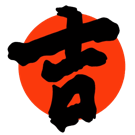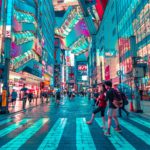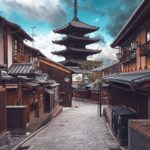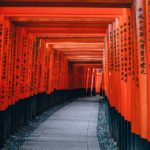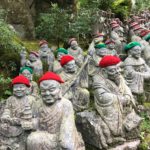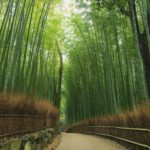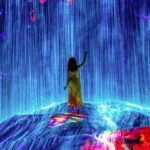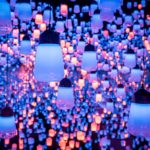Day 1: Tokyo
We don't like to bombard our clients on their first day. We typically keep the activities to a minimum, and allow guests to acclimate to their surroundings. All of our guests receive a restaurant recommendations list from us, so it's also a chance to relax and have a nice dinner. Having said that, the activities that we are recommending for today are mainly focused around the man-made island of Odaiba. It houses a lot of Japan's futuristic tech, and even getting there is a treat as the train that goes there is one of Japan's only fully automated, unmanned monorail trains. The views are also really nice. Once there, TeamLab's Borderless or Planets exhibits (I will discuss the difference between the two with you), and a massive arcade are the two activities for the day. Return to Tokyo will be arranged by sea bus, so that you can see Tokyo Bay and Rainbow Bridge at night from the water. Suggested Accommodation: Muji Hotel Highlights:
- Tokyo Sky Tree or Tokyo Tower (time permitting)
- Automated monorail train ride to Odaiba
- TeamLab's Borderless or Planets
- Giant Arcade
- Boat ride across Tokyo Bay
Day 2: Tokyo
This day is all about seeing the traditional side of Tokyo. Sensouji is one of the most iconic temples in Japan, and is the perfect place to learn about Japan's spiritual heritage as it has both a temple and a shrine on its grounds. It's a great spot to start the day. Asakusa is also one of the best neighborhoods in Tokyo for easy access to street-ish foods. It's known for its sweets and so a small lesson on how to make your own traditional Japanese candies, and a street food tour would be a good way to continue the day. We typically plan all of our own street food tours, and the Asakusa area has the follow to offer:
- Yakitori
- Yakidango
- Kibidango
- Age-manju
- Mattcha gelato
- Nikuman
- Taiyaki
- Ninja Sake vending corner
- Sensouji Temple (guided)
- Asakusa Food tour (guided)
- Sake taste-testing / learning (guided)
Day 3: Nikko
Today you'll travel to Nikko, home of the UNESCO World Heritage-listed Toshogu Shrine. Mausoleum to Japan’s last shogun, this ornate shrine is one of the most beautiful in Japan, full of masterful wooden carvings, and a marked contrast to traditional Shinto structures. Set against a backdrop of soaring trees and expansive forest, it's a far cry from the busy streets of Tokyo.
Toshogu Shrine is by far my favorite shrine in all of Japan. Nikko in general is a wonderful place, and the journey there is made better by aa private compartment on your train journey. Train rides, I personally feel, are such a nice way to travel around Japan, and this one is quite unique as most first class seats in Japan are not cabin-style.A short walk south will take you to Rinnoji, Nikko's most famous temple. Explore the grounds at your leisure, visiting a treasure house displaying fascinating exhibits, a small yet charming Japanese garden, and a shrine that’s said to house Nikko's three mountain gods.
Before heading back to Tokyo and saying goodbye to your guide, treat yourself to a lunch of soba and yuba, two of Nikko's most distinctive dishes. This should be guided.
Day 4: Tokyo
I've planned today around some of your suggestions, but I've mixed it with things that are unique to the area that you'll be visiting. You had the Robot Restaurant, and Golden Gai on your itinerary, both of which are in the Shinjuku area (walking distance from one another). I love the over-the-top, camp performance at the Robot Restaurant, but it is definitely NOT a restaurant! So to balance this out, I planned another food tour for this day before the show. Shinjuku is home to the largest community of Korean people in Japan. The neighborhood is famous for its Korean street food, and restaurants, so our tour blends Korean food, with the also famous Japanese depachika offerings of Takashimaya. Some of what is included is:
- Hotteok
- Tteok-bokki
- Sannakji
- Tempura
- Gyouza
- Onigiri
- Umeboshi
- Kushiage
- Samurai Museum (guided tour)
- Korean / Depachika Street food tour (guided)
- Robot Restaurant
- Golden Gai bars
Day 5: Tokyo
Today is a slightly quieter day as far as activities are concerned. You mentioned Tsukiji Fish Market in your notes, however Tsukiji was shut down years ago, when Tokyo was prepping for the Olympics. They have moved the market to Tokyo Bay's Toyosu island. So today I'd like to pair you with a sushi chef who you will go to the market with, choose your own fish to prepare later on, and then make sushi in his kitchen. If Day 2's sake info wasn't enough, he can also teach you about which spirits are best paired with which fish as well. It's an amazing experience, and gives you access to the fish market that you wouldn't normally have. The rest of the day will be left open for personal adventures. Highlights:
- Toyosu Fish Market
- Sushi making lesson
- Sushi / sake pairing lesson
Day 6: Tokyo
Today the focus should be on the sumo tournament. It can get crowded, and so the only other planned activity is a tour of Akihabara. The neighborhood is known as being the mecca for all things 'anime', but it is home to many other forms of Japan's glorious nerdom. It's also a hotspot for engineering students, and there's even a shrine where you can have your electronic devices 'blessed' by a shinto priest. My suggestion from here is to visit the Izu Islands. You mentioned the Mario Kart tour in Tokyo, and I think that it is a great way to see the city, and get a feel for its distinct neighborhoods, however Hachijojima is one of the few locations outside of Tokyo that also have go-kart that you can drive around the island. The island itself is a large volcano in the middle of the sea. It is one of my personal favorite places to visit in Japan. You will go by sea. An overnight ferry is the best way to go. Journeys back to the mainland will be arranged by air (45 minute flight). Highlights:
- Akihabara Tour (guided)
- Sumo Tournament
- Mario Kart Tour
Day 7: Lake Kawaguchi
Lake Kawaguchi - Sticking with the theme of places that are around or near the Mt. Fuji area (based on Hakone being on your list of places you wanted to visit), Lake Kawaguchi is a wonderful place to visit during this time of year as there are typically many flowers that are blooming, and the temperature is bearable. Also this area has an amazing open-air museum that will allow you to try your hand at traditional Japanese crafts, and also soba making. There is also a gondola near the lake for a better chance at viewing Mt. Fuji than you would get at Hakone. Accommodation: yl&co or Hoshinoya's Fuji accommodation *NOTE: The itinerary for this day may be switched around to focus more on Mt. Fuji, and less on the crafts. This is because the crafts village is similar in nature to Takayama/Ogimachi/Shirakawago. They are different, but it could present a possible overlap. Also, because of the vast distance between here and Hiroshima, the journey from here to there will be around 6 hours (via a normal train + a bullet train), thus I've removed the daytime activities from the next day and would like to place them on the morning before departing Hiroshima (currently Day 13), as they will not take very long, and are not far from the train station.
Day 8: Hiroshima
It is mandatory for all students in Japan to visit Hiroshima during their primary education. Japan is a country of peace, and Hiroshima has taken the torch on embodying this resounding message, not just within Japan, but throughout the world. The Peace Memorial Park is not just an important place to visit for Japanese kids, but is an important place to visit for all people of both current and future generations. The lessons taught by the informative guides (most of whom have been directly impacted by the events in Hiroshima), will impart not only the importance of peace, but the devastation that war can bring. The visit to the park will also include a stop at the A-Bomb Dome, which was intentionally left in its state as a reminder to the world. Hiroshima is somewhat of a culinary hub for Japan. The Seto Inland Sea provides some of the most delicious seafood in the country, and is the perfect climate for their delicious lemons and olives. You can expect to taste food from all over the world, however the place that is most important to visit (in my opinion) is the Okonomimura. It is basically a 5-story building with around 30 or so restaurants that all have their own take on the same dish, Hiroshima-style okonomiyaki. The preparation is in and of itself a performance. The cooks will use a teppan grill to cook the food in front of you. Highlights:
- Hiroshima Castle (time permitting)
- Okonomimura (guide suggested)
- Food district (guide suggested)
Day 9: Miyajima
Miyajima literally means, ‘shrine island’. It is a sacred place that has a very fascinating history that extends beyond the UNESCO World Heritage Shrine, and the beautiful torii gate that appears to be floating on the sea. Miyajima is also special in that its structures have been largely untouched by natural disasters, and thus the temples and shrines that you'll be visiting here are mostly original, and in some cases date back as far as the late 1500’s. The island is also home to many adorable deer which roam the streets freely amongst the people. There will be a short hike on this day to the top of Mt. Misen, which is a sacred mountain in the Shinto belief system, and has been worshipped for over 800 years. The view of the Seto Inland Sea from the top of the mountain is spectacular, and a great finale to your time in Hiroshima. Highlights:
- (everything on this day should be guided)
- Deer roaming the roads with you
- Itsukushima Shrine
- Floating Torii Gate
- Shopping area near Itsukushima Shrine
- Short hike to the top of Mt. Misen
Day 10: Kyoto
*NOTE: I've switched the first and last days in Kyoto around to accommodate for experiencing the Peace Memorial Park in Hiroshima. The other days require advanced reservations and/or waking up relatively early to get to them on time. The other option would be to add an extra day to Hiroshima. Today will be more focused on some of Kyoto's more famous historical sites. I think that the best way to travel between the two is on bike. Japan is similar to Holland in that many people typically bike around the city instead of driving. It can be dodgy at times, but it is a wonderful way to take the city in. Riding along the Kamogawa (river) that flows in the middle of the city is also really nice at this time of year, as there are typically people performing music along the river when the city warms up. The locations that I think would be best are:
- Kiyomizudera
- Yasaka Shrine
- Fushimi Inari
- Nishiki Market
- Kinkakuji (if you're up for a challenge, as it is a bit far)
Highlights:
- Hiroshima - Peace Memorial Park (guided)
- Hiroshima - A-Bomb Dome (guided)
- Temples/Shrines/Locations mentioned above
- Bike riding through the city
- Japanese kanji calligraphy lesson (time permitting)
- Dinner on the river (?)
Day 11: Kyoto
Today I wanted to plan some more 'romantic' activities for you guys. All of today's activities are slower paced, but relaxing, and dreamy.
There is a beautiful valley river just outside of Kyoto, where there are teams of people who will take you down it on a 3-man boat. This is actually the river that many people used to travel between Osaka and Kyoto in bygone eras. One of the best ways of reaching the area is the beautiful open-air steam-engine train that travels along the river to get you there.
It's a very nice way to start the day, and is super refreshing. You see a lot of monkeys and deer along the river too, and there is a really cool boat that pulls up next to you guys (also a traditional boat) with a grill that sells octopus or squid, and beer. The ride is relaxing and cozy.
Tenryuji is a UNESCO World Heritage Site and has what is considered one of the most beautiful zen gardens in the entire nation. It's located in Arashiyama, which is the last stop on your boat journey. An area that is known for its temples and shrines, and the picturesque bamboo thickets in the area (you listed this one in your notes).
Pontocho is crammed with amazing restaurants, a lot of which specialize in Kyoto's famous banzai-style dining. It's best experience by walking through the entire area to soak up the vibe, and then following your nose to where you'd like to go most. However we can make recommendations and reservations.Highlights:
- Open-air valley steam-engine train
- Hozugawa Kudari (boat is manned)
- Arashiyama tour (semi-guided)
- Short hike of Mt. Iwatayama (monkeys everywhere here)
- Tenryuji Temple Zen Garden (semi-guided)
- Arashiyama Bamboo Thicket
- Pontocho Alley for dinner
Day 12: Kyoto
The taiko lesson would place the two of you in a classroom setting with other guests, and your teacher will instruct you on how to play a taiko drum before you all play together. After that, I think the Gekkeikan Sake Museum is the best place to visit. I've been there a ton of times and I do think it is a great place to understand how sake is made, but also the history of sake (nihonshu in particular), and its connection to Japanese spirituality. At night in Gion, there is a Geisha show. It isn't a private one, but one that is open to the public. It also combines the performance with other traditional Japanese arts (comedy, and shamisen performances as well), so that you get a taste of the performing arts that Kyoto is known for.
Highlights:
- Taiko drumming lesson
- Gekkeikan sake museum tour
- Geisha Show
- Dinner on the river (?)
Day 13: Osaka
As the last day of your journey, I wanted to keep it simple. Two main activities. One during the day, the other at night. I think Osaka Castle is a must-see, must-visit place in Osaka and it's my 2nd favorite castle in Japan (Himeji Castle is #1). As it was on your list, it only made sense to add it. You don't need a guide for this castle. It is very well planned out, and there are a lot of things that include English. The castle is important not just for its historical significance, but you also get a sense of the pride that Kansai people have when you visit. Since this is your last day, outside of the castle I've left the day open. Osaka is definitely a night city, so most of the really interesting things there happen at night. The people are generally far more open and honest than their Kanto counterparts as well. Visiting Shinsekai, and Tsutenkaku also don't require a guide, in my opinion so this would be the perfect time to check them off of the list. What I think may require a guide is the nighttime food tour of Dotonbori. When I think of street food in Japan, Osaka is the first place to come to mind. Also, there is nothing else like Dotonbori. You could walk up and down the streets and never get bored. It's beautiful and extravagant. The nighttime cruise along the river is the best way to take it all in. There are also some really good karaoke bars in the area if you are interested in singing until midnight.
Highlights:
- Osaka Castle
- Night cruise
- Dotonbori food tour
Day 14: Osaka
Today will be completely dedicated to enjoying USJ.
Day 15: Koyasan
The time spent here will mostly be centered around getting a taste of what life is like for Buddhist monks in Japan. All of the activities are centered around that theme. Koya-san is one of Japan's spiritual centers, and one of the most accessible for overseas visitors. The temple I have planned for you guys to stay at is one of the best for non-Japanese speaking people as the head monk has spent time overseas, and thus can speak English (along with other monks that stay here). The main activity for this day is visiting the Okunoin Temple, which doubles as a mausoleum for Kobo Daishi (the founder of this regions Buddhism denomination, and as a cemetery for many others), at night with one of the monks from the temple you'll be staying at. Food-wise, most regions in Japan that were settled by monks have what is called shojin-ryouri. It is an all-vegetable cuisine that many monks eat during intense meditation periods. Highlights:
- Nighttime Tour of Okunoin Cemetary (guided by a monk)
- Shukubo (staying in a temple with the monks)
- Buddhist Meditation (guided by monk)
- Shojin Ryouri
- Goma Prayer Ceremony (guided by monk)
Day 16: Travel from Koyasan back to Tokyo
Getting to Tokyo from Koyasan is going to be a long journey (5-6 hours depending on departure time), so I don't think planning activities on this day is essential.
